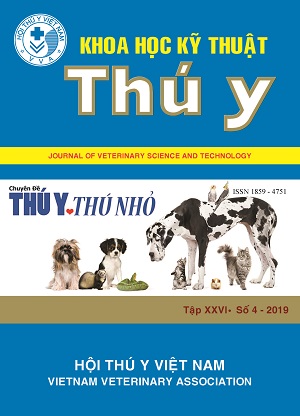Situation of parasitic helminth infection in storks (Agretta gazretta) in Vinh Long province
Abstract
The situation of parasitic helminth infection in the storks (Agretta gazretta) in Vinh Long province was conducted from October 2017 to October 2018. A total of 115 storks were dissected, then helminths were collected, and their species were identified basing on the external and internal morphology of the helminths in adult stages. The studied results illustrated that the storks were infected with helminths with high infection rate, up to 80.00%. The infection rate of storks with helminths increased gradually by the stork body weight. The storks having body weight lower than 100g were infected with the lowest infection rate (65.79%), then the stork group weighing from 100 to 200 g was infected with the higher rate (80.00%), and the highest infection rate belonged to stork group weighing over 200g (94.59%). The gender of stork was not affected to the infection rate with helminths. In this study, there were 6 helminth species which were detected in the storks, they were belonged to 2 classes: Trematoda and Nematoda. In the Trematoda class, there were 5 parasitic species, such as: Hypoderaeum conoideum contributed the highest infection rate (22.61%), followed by Echinostoma revolutum (18.26%), Echinoparyphium recurvatum (14.78%), Echinostoma aegyptica (12.17%) and the lowest infection rate was Cotylurus cornutus (10.43%). Most of the parasitic species were detected in the stork intestines but only one species Ganguleterakis dispar was found in the stomach (9.57%). Among the parasitic helminth species in the stork, Echinostoma revolutum and Echinoparyphium recurvatum species were identified in many hosts, such as: dog, cat, pig, wild birds and also in human

